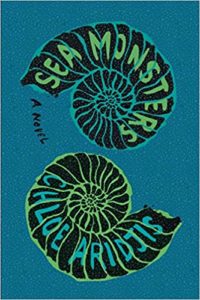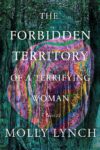 [Catapult; 2019]
[Catapult; 2019]
Sea Monsters by Chloe Aridjis is an offing of teenage reveries; the reader is on the shore and the prose—describing the protagonist Luisa’s memories, experiences, and locations—ebb and flow constantly, referring to mysteries known and unknown, produced as much as they are erased by the sea. The entirety of the novel, reading like a short chapter in the coming-of-age of Luisa, portrays a para-nautical limbo, constantly referencing the sea but never sending its characters far into actual seawater. What’s more, gothic doubling and dopplegängers seem to comprise the rest of the symbolic machinery powering this protagonist’s small quest for the most elusive of the ideal and the material—that is, a search for identity, authentic love, and a troupe of dwarves recently escaped from a Soviet circus touring Mexico. And while the execution of this novel supplies a hybrid-gravity of folklore, history, poetry, and science, the absence of imminent danger or risk made it easy to feel distant from the story itself.
From the very beginning of Luisa’s story, life can go nowhere without a doubled, paradoxical version of itself:
“Imprisoned on this island, I would say, imprisoned on this island. And yet I was no prisoner and this was no island.”
These first lines of the novel seem to pick up a canonical scenario—depicted in Charrière’s Papillon, Gillman’s “The Yellow Wallpaper,” and Butler’s Dawn—but this is only due to the baggage words like “island” and “prisoner” carry with them. The island that is not an island is the Oaxacan beach Zipolite—“The Beach of the Dead,” the name being, among other things, a possible misspelling of the word zopilote, referring to “a black vulture [that] would envelop the beach in its dark wings and feed on whatever the waves tossed up”—and Luisa is anything but a prisoner; she is a teenager from La Roma of Mexico City and is about to graduate from Colegio Campus Americano with the children of industrialists, politicians, and Americans working for transnational companies. Sure, it is a story of escaping/breaking free, but the bondage is one of middle-class routine—the expectation that Luisa will work through her 80’s new wave angst, graduate from school and follow in the footsteps of her professional parents.
Luisa only finds herself an island-prisoner without an island or a prison after meeting her love interest, Tomás Román. New to the neighborhood, he first appears giving a coin to an organ grinder in the street, second by “a pile of ruins on Chihuahua…one of the most dramatic expressions of the collapse…concrete slabs and shattered glass seeming to multiply and mosaic over time” (a description of the lingering aftermath of the 1985 Mexico City earthquake), and third in an abandoned mansion that Luisa and her friend Julián happen to be exploring and taking pictures of themselves inside: “As I began to photograph [Julián], his figure seemed to double. At first I thought it was his shadow but the contours didn’t match up.” Out of this doppelgänger-ing of Julián, Tomás fully emerges. He is a dropout; he works at a bookstore called A Través del Espejo; he wears all black and reeks of pot; he hangs out in abandoned mansions alone. Luisa, adrift in privilege and opportunity, beholds the brooding image of authenticity that Tomás represents for her and, after they depart, becomes infatuated with him. By the middle of the novel, this doubling process repeats itself with another lover she calls the merman. The infatuation with (the fantasy of) Tomás (and later, the merman) float in good company. While this device is intellectually interesting for the first quarter of the novel, Luisa’s romantic journeying remains abstract—it’s hard to tell whether or not the doubling device is serving Luisa’s story or if Luisa’s story is just the elaborate filigree of Aridjis’s commitment to a gothic wondering.
The sea here, of the earth and of Luisa’s mind, does not stray from what it often represents in other stories—the unknown, the sublime, the indifference of nature to paltry human problems, the beauty and power of metamorphosis, adventure, etc. This is not to say the primary settings of the novel of 1988 Mexico City and Zipolite are lacking their own pelagic qualities in the story. As the title might indicate, Aridjis writes of a world where the influence of sea monsters are not limited to their movements through bodies of water like the Pacific Ocean or the Mediterranean Sea. Sea monsters, especially the way Luisa thinks about them, are more of a lens for understanding the world; most importantly, they are indicative of shipwrecks. As Luisa hears from her father,
“Shipwrecks fall prey to all sorts of appetites…the appetite of water, the appetite of sea creatures, the appetite of time. In the Mediterranean there are three main saltwater macro-organisms that share a fondness for ancient timber: the shipworm, the wood paddock, and the marine gribble. All three contribute to the stratification and contamination of the wreck.”
The richness of this metaphor—the simultaneity of urban, social and interpersonal decomposition and renewal portrayed by Aridjis—is the driving force of this novel. Again, a fascinating engine, but a force that stopped at intrigue before it got to emotional investment.
The reality of literal sea monsters is that they are tiny termites of the sea—much less visually dramatic than Moby Dick or giant squids, but just as invisible to the naked eye, even in their commonality. These tiny sea monsters work in tandem with fungi and bacteria to burrow into wood and live their lives gorging and mating amongst “wave action add[ing] to the process of demolition.” This is the bedrock of literary allusion in the novel: the decomposition caused by the 1985 Mexico City earthquake and the flood of European immigrants who populate the city in its wake are the background, while the foreground portrays Luisa’s coming-of-age as she is about to graduate high school and decides—as youths in angsty tales are wont to do—to run away from the familiarity of her home and burrow into the mystery of a strange new place. Luisa is given permission to do this by learning of these creatures and the lives they live in the evidence of mythic shipwrecks, imagining these creatures getting “access to something vertiginously distant and mysterious…that of Antikythera, which had lain at the bottom of the ocean for over twenty centuries.” She feasts on this ancient shipwrecked wood as much as the shipworms, wood paddocks, and marine gribbles through the novel. She is a drifter by nature; her appetite seeks the myth of wrecks—ships, cities, and people—anywhere they may appear.
Everything seems to be affected by Luisa’s perception of the aforementioned “Antikythera Mechanism.” It’s a device that doubles for Luisa as a mysterious bronze object found in the ship of that name—described as an “ancient clock, calculator, calendar, computer” that archeologists are still trying to understand—and as a lens formed by Luisa’s reading of the Baudelaire poem “Un Voyage à Cythère,” depicting a
“poet’s heart…swooping about like a bird, free and happy around the rigging, but soon that buoyant spirit gets ensnared in gloomy pessimism and the poem ends with a macabre image of the sacrificed poet hanging from the gallows.”
This poem becomes the model for the destruction of the romantic as one gets closer to its authentic core. And so the force Luisa believes is working against the romantic as one approaches it imbues all of her movements through the book. The material-world becomes the mythic, the mythic become the mundane, the mundane becomes the beautiful, the beautiful can only be beautiful if it is mysterious, and uncovering a mystery is never as satisfying as the unknown her mind so earnestly feasts upon until nothing mysterious is left. It is the prophecy of her tale as it were, with her story ultimately, and unfortunately, sparing the reader from anything as macabre as Baudelaire’s verse.
While introducing the reader to Zipolite, Luisa’s acumen for generating epiphanies is constantly linked to the twilight between adolescence and adulthood she’s found herself in: “It’s easier to reconcile yourself with sunny places if you can imagine their nocturnal counterpart.” Aridjis’s epiphanies (via Luisa) are fantastic in every sense of the word; they are entertaining and they come out most genuinely while Luisa is negotiating fantasy, myth, and reality, her thoughts and statements often toeing the line between observation and aphorism. Luisa understands that a “tectonic plate dispatches a telegram” to Mexico City in 1985, her thoughts are “gargoyled in the margins” of her schoolwork, she feels the city and the weather become “a punctuation mania of the elements, the angry question marks of car horns…and the exclamation marks of antisocial rain [are] beating down on heads and shoulders.” Luisa’s atmosphere, internally and outwardly, regards language as mythic and elemental unto itself. Unfortunately, the events of this story pale in comparative thrust to Luisa’s fabulist observations, yielding the portrait of a young woman whose primary conflict is that of being assailed by her own unrelenting fabulism.
Often, risk and desire reinforce each other, but Aridjis troubles the place where these two concepts meet. After Luisa goes with Tomás to see the lucha libre, he mentions that their matches are choreographed; Luisa, who is glad she didn’t know this during the matches and wonders about Tomàs’ “display of suspense, why he had appeared so rapt when he’d known all along that the struggle wasn’t real.” Her skepticism of his enjoyment is relatable—if the matches are decided before they happen, what is there to be invested in? What is the risk? Why care? Of course, the performance itself, the agreement that pretending together—virulently, physically, and en masse—can measure up to, if not totally eclipse, the authority of authenticity. This moment is a fragment speaking to the general whole of this story: Luisa’s expectations of love and conflict do not include pretending or performing. Outside of fantasy, love and conflict are just scenarios, and she is just someone present during their eventual appearance. But what is more authentic: participating in the performance or refuting it?
Aridjis treats the appearance of love’s classical conflict—young lovers running away together and young lovers separating—as just that: an appearance, a performance, an obvious and mundane phase of life diluted of rage, explicit sex, betrayal, cosmic harmony, and the rest of those tried and true teenage tribulations (I suppose these feelings are felt by Luisa, but their effects are rather mild). Luisa’s perceptions of Tomás and the aforementioned merman—a fellow who quietly and seriously builds sandcastles on the beach and who she assumes is Eastern European, mostly for his lack of speech while they drink together—quickly find a similar fate on the rocks of her imagination; they are the nocturnal places she desires that are ruined by their sunny counterparts (re: Luisa’s epiphanies):
“[Tomás] had traded his fitted black garments for linen, white and baggy, and there was something childlike about his appearance, vague and undefined, that didn’t suit him. This was TR, I told myself, TR. The same person from…the abandoned house…”
and
“With something like vertigo I looked up at the face, half refuged in the shade of a cap. Gustavo. The merman was a lanchero named Gustavo…Unlike the afternoon of the sandcastle, the sun now erased all Slavic accents and geometry…Spanish, rather than some unfathomable tongue.”
Luisa is betrayed by her fantasies of these men dying in the face of their corporeal dimensionality. One-dimensionality is fuel for mystery, and mystery is what Luisa loves; when other sides of Tomás and the merman are revealed, when the context of their meetings shift, her perceptions shipwreck, perhaps becoming food for other hungry organisms swimming in her mind.
The tonal-darkness of this novel is ever-present (due largely to the baggage of concepts and words as I noted earlier) and completely absent at the same time (as “baggage” rarely indicates a physical presence). More, there are no chapter demarcations, which reads like a structural nod to the opaque quality of the ocean, blurring Luisa’s experiences and memories of Mexico City and Zipolite together constantly. And the ever-wandering flow of the prose comprised largely of reveries makes the novel feel like a journal dripping with nostalgia. Nostalgia is slow; nostalgia is sublime; nostalgia is paralyzing; nostalgia is the pain of knowing something formatively joyful is gone and can never be joyful in that original way ever again; nostalgia is the pain of a double-state, a happiness at the root of a sadness. Without a more emotional hook, this is the opaque and doubled place of Aridjis’ work I buried myself in, a place where “night doesn’t fall, it rises,” where “thermal inversion” is responsible for everything from Mexico City’s basin meteorology to government cover-ups, prison-breaks, and zoo directors dealing in wild animal skins; a place where revelations constantly find new things to hide about themselves.
It’s odd living with a character in a novel who seems so secure. I admit that it’s unfair to assume that she is—her narration does betray unreliability and naivety that she does attempt to compensate for—but Aridjis’s plot omitting serious follies, lessons learned, shame felt and joy experienced that a typical bildungsromamn might try to reckon with is a prominent void of this story (Luisa is nervous to face her mother at the end of the novel, but a precedent for possible repercussions of her actions is never set). I might be wishing that Luisa was tested more by uncertain and nerve-racking situations, but I’m also remarking on the slyness of the conflict Aridjis uses to get readers to care about Luisa’s life. Meaning: I regularly found Luisa’s perceptions fascinating, but at no point in the story did I feel that gratifying “need to know what will happen next” type of feeling. This might be the risk of committing to total nostalgia: its reading hinges far more on logos than pathos, on fascinating facts and lore rather than juicy misfortunes and their reversals.
Despite its title, there are no archetypal monsters; no villains; no lovable characters compelled by circumstance to commit immoral acts; no impossible odds to overcome; no serious betrayals portrayed or retributions gone too far. People and events of this nature are alluded to at points, but Aridjis avoids entertaining her readers with hatred for and/or fear of her primary characters. Without these relationships to the characters, this novel stays rooted in a state constantly before and after baser states of fear (and joy for that matter).
Shortly before her father finds her in Zipolite and takes her back to Mexico City, Luisa thinks
“…few sights reminded me of the city, that was a lifetime ago, or rather a parallel life, or another Luisa who lived in La Roma, housed, schooled, and parented, and I preferred to continue my thoughts to the present. Yet before long, they were thrown back to the city.”
So I’ve come to read the book as an alternate proximity to conflict: the paradox of Luisa’s sense of self collapsing and rebuilding without an obvious enemy to focus on amidst the uncertainty of incipient adulthood. Though I yearned for an emotional hook that never presented itself, I can’t deny the allure of portraying life, especially in transitional moments, as a chaotic lingering between reality, memories, structures, and dreams; Aridjis’s facility for depicting this mysterious braid of experience is as unstoppable as the hulking force of the ocean crashing and spreading itself thin and glassy across ancient layers of sand.
Giovan Alonzi’s writing has appeared in 7×7.la,Entropy, PANK, VOLT
This post may contain affiliate links.







